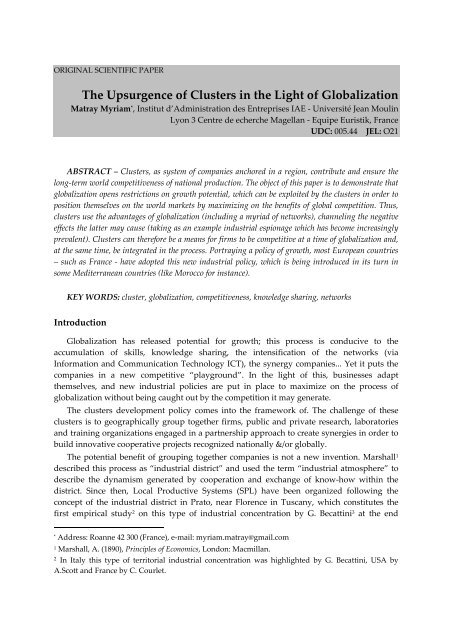Twice a Year Scientific Journal
Twice a Year Scientific Journal
Twice a Year Scientific Journal
Create successful ePaper yourself
Turn your PDF publications into a flip-book with our unique Google optimized e-Paper software.
ORIGINAL SCIENTIFIC PAPER<br />
The Upsurgence of Clusters in the Light of Globalization<br />
Matray Myriam * , Institut d’Administration des Entreprises IAE - Université Jean Moulin<br />
Lyon 3 Centre de echerche Magellan - Equipe Euristik, France<br />
UDC: 005.44 JEL: O21<br />
ABSTRACT – Clusters, as system of companies anchored in a region, contribute and ensure the<br />
long-term world competitiveness of national production. The object of this paper is to demonstrate that<br />
globalization opens restrictions on growth potential, which can be exploited by the clusters in order to<br />
position themselves on the world markets by maximizing on the benefits of global competition. Thus,<br />
clusters use the advantages of globalization (including a myriad of networks), channeling the negative<br />
effects the latter may cause (taking as an example industrial espionage which has become increasingly<br />
prevalent). Clusters can therefore be a means for firms to be competitive at a time of globalization and,<br />
at the same time, be integrated in the process. Portraying a policy of growth, most European countries<br />
– such as France - have adopted this new industrial policy, which is being introduced in its turn in<br />
some Mediterranean countries (like Morocco for instance).<br />
KEY WORDS: cluster, globalization, competitiveness, knowledge sharing, networks<br />
Introduction<br />
Globalization has released potential for growth; this process is conducive to the<br />
accumulation of skills, knowledge sharing, the intensification of the networks (via<br />
Information and Communication Technology ICT), the synergy companies... Yet it puts the<br />
companies in a new competitive “playground”. In the light of this, businesses adapt<br />
themselves, and new industrial policies are put in place to maximize on the process of<br />
globalization without being caught out by the competition it may generate.<br />
The clusters development policy comes into the framework of. The challenge of these<br />
clusters is to geographically group together firms, public and private research, laboratories<br />
and training organizations engaged in a partnership approach to create synergies in order to<br />
build innovative cooperative projects recognized nationally &/or globally.<br />
The potential benefit of grouping together companies is not a new invention. Marshall 1<br />
described this process as “industrial district” and used the term “industrial atmosphere” to<br />
describe the dynamism generated by cooperation and exchange of know-how within the<br />
district. Since then, Local Productive Systems (SPL) have been organized following the<br />
concept of the industrial district in Prato, near Florence in Tuscany, which constitutes the<br />
first empirical study 2 on this type of industrial concentration by G. Becattini 3 at the end<br />
*<br />
Address: Roanne 42 300 (France), e-mail: myriam.matray@gmail.com<br />
1<br />
Marshall, A. (1890), Principles of Economics, London: Macmillan.<br />
2<br />
In Italy this type of territorial industrial concentration was highlighted by G. Becattini, USA by<br />
A.Scott and France by C. Courlet.
















